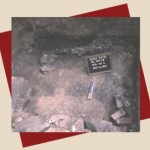Over the years, there have been a variety of formal and informal efforts to clearly define and identify who and what was here before our modern day world. Here is an overview of some of the digs and searches held at the Historic Square area, which houses the Judson House, Museum, Eagle Hotel and Washington Park.
Excavations at Fort Presque Isle on the property of the Soldiers and Sailors Home and at the location of Waterford’s Fort LeBouf, the French and Indian War Period military fort built by the French in 1753 were explored by the Archaeological Division of the Frontier Forts and Trails Survey. One of the blockhouses was uncovered at the former site and charred logs and timbers were systematically revealed at the latter. In certain areas along the 18th century trail that connected Presque Isle and Le Boeuf, workers found remnants of a corduroy road where sections of logs were laid side-by-side over otherwise impassable areas to facilitate the transport of military goods and soldiers.
Site Name: FORT LeBOEUF SITE/WATERFORD HISTORICAL COMPLEX (36ER65) – Closed
Location: Waterford Borough, Waterford Township
Author: Renata B. Wolynec, Ph. D.
Representing: Edinboro University of PA
Date of Site: 1753-present
Project Sponsor:Edinboro University of PA in cooperation with Pennsylvania Historical and Museum Commission and Erie County Historical Society
The Waterford Historical Complex is a multi-component site which includes the remains of French (1753), British (1760), and American (1796) military occupations and two intact historic buildings (the Eagle Hotel (1826) and the Amos Judson House (1826)) associated with the town of Waterford, PA. The French fort known as Fort de la Riviere aux Boeuf was the site of George Washington’s first important mission as an officer. His journal, recounting the events of this very dangerous mission, remains a popular publication in Williamsburg, VA. Since 1975, excavations have focused on the search for the French and British fort remains as well as on the areas surrounding the Eagle Hotel and Judson House.
Although few artifacts from the colonial period were found, large areas of wood charcoal in the vicinity of the Judson House suggest the remains of either the French or British forts (both were destroyed by fire). Remains from the American period are much more plentiful, numbering over 160,000 artifacts and garbage remains. Old entrances and a past porch were discovered associated with the Judson House. The remains of a root cellar, ice house, and kitchen were discovered in association with the Eagle Hotel.